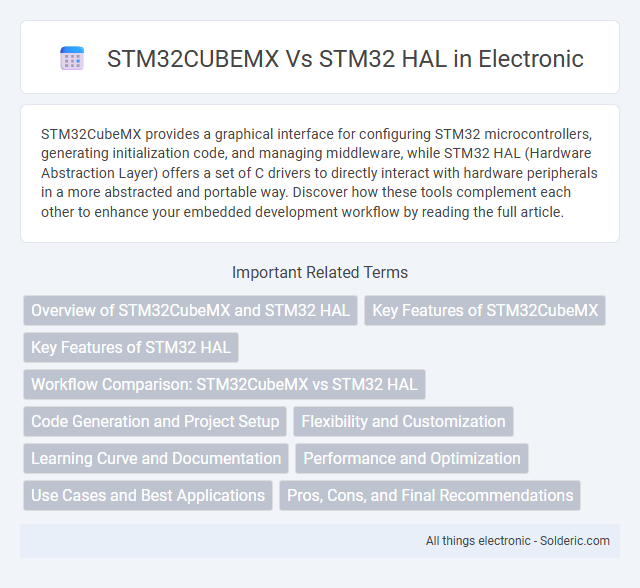STM32CubeMX provides a graphical interface for configuring STM32 microcontrollers, generating initialization code, and managing middleware, while STM32 HAL (Hardware Abstraction Layer) offers a set of C drivers to directly interact with hardware peripherals in a more abstracted and portable way. Discover how these tools complement each other to enhance your embedded development workflow by reading the full article.
Comparison Table
| Feature | STM32CubeMX | STM32 HAL |
|---|---|---|
| Type | Graphical Configuration Tool | Hardware Abstraction Layer Library |
| Primary Function | Pin and peripheral configuration, code generation | API for peripheral control and hardware abstraction |
| Output | Initialization C code, project setup | Firmware libraries for STM32 peripherals |
| User Interface | GUI-based | Code-based (APIs) |
| Dependency | Requires STM32Cube HAL or LL libraries for generated code | Standalone library for STM32 peripheral access |
| Customization | Pre-generated code with limited editing | Full code-level customization and extension |
| Supported STM32 Series | All STM32 microcontrollers | All STM32 microcontrollers |
| Use Case | Rapid prototyping and project initialization | Low-level peripheral programming and control |
Overview of STM32CubeMX and STM32 HAL
STM32CubeMX is a graphical configuration tool designed to simplify microcontroller initialization and peripheral configuration for STM32 devices, enabling quicker and error-free project setup. STM32 HAL (Hardware Abstraction Layer) provides a comprehensive set of C APIs that abstract low-level hardware details, facilitating application development across various STM32 microcontrollers. Both tools are essential components within the STM32 ecosystem, with STM32CubeMX generating initialization code that utilizes STM32 HAL libraries for streamlined development.
Key Features of STM32CubeMX
STM32CubeMX offers an intuitive graphical interface for configuring STM32 microcontrollers, enabling you to generate initialization C code automatically and reduce development time. Its key features include pin configuration, clock tree setup, peripheral assignment, and middleware support, streamlining hardware abstraction and project initialization. This tool integrates seamlessly with the STM32 HAL library, ensuring optimized and consistent code generation for your embedded applications.
Key Features of STM32 HAL
STM32 HAL (Hardware Abstraction Layer) provides a comprehensive collection of APIs designed to simplify peripheral configuration and management on STM32 microcontrollers, offering a high level of hardware abstraction for easier code development and portability. Key features include ready-to-use drivers for peripherals, middleware integration, and support for interrupt and polling modes, enhancing real-time application control. Your STM32 projects benefit from STM32 HAL's modular and scalable architecture, which accelerates development and ensures smoother integration with STM32CubeMX-generated initialization code.
Workflow Comparison: STM32CubeMX vs STM32 HAL
STM32CubeMX streamlines the development process by providing a graphical interface to configure microcontroller peripherals, clock settings, and middleware, generating initialization code automatically. STM32 HAL offers a comprehensive firmware library enabling low-level hardware abstraction and peripheral control through C API functions, requiring manual code integration and customization. Your workflow benefits from STM32CubeMX's rapid setup and code generation, while STM32 HAL delivers detailed control for fine-tuning and extending functionality.
Code Generation and Project Setup
STM32CubeMX offers intuitive graphical code generation and project setup, enabling automatic initialization of peripherals and middleware tailored to user selections. STM32 HAL provides low-level hardware abstraction layer drivers that require manual configuration but allow fine-grained control over peripheral registers and behavior. STM32CubeMX streamlines development by producing ready-to-use initialization code, while STM32 HAL requires developers to implement and customize code based on specific application needs.
Flexibility and Customization
STM32CubeMX offers extensive flexibility by enabling developers to configure pin assignments, clock settings, and peripheral initialization through an intuitive graphical interface, which automatically generates initialization C code tailored to project specifications. STM32 HAL provides low-level hardware abstraction with modular drivers that can be customized by modifying initialization and peripheral management routines, granting deeper control over hardware behavior. While STM32CubeMX accelerates development through automated setup and code generation, STM32 HAL allows fine-tuned customization for optimized performance and application-specific requirements.
Learning Curve and Documentation
STM32CubeMX offers a graphical interface that simplifies the initial configuration of STM32 microcontrollers, making it accessible for beginners by reducing manual code setup. STM32 HAL (Hardware Abstraction Layer) provides detailed and extensive documentation aimed at embedded developers who need fine-grained control over peripherals, but it often requires a steeper learning curve due to its complexity. Comprehensive user manuals and example projects for both tools facilitate progressive learning, with STM32CubeMX easing configuration and STM32 HAL enabling deeper hardware interaction.
Performance and Optimization
STM32CubeMX generates initialization code that provides a streamlined foundation optimized for STM32 microcontrollers, enabling faster configuration and reduced development time. STM32 HAL offers a comprehensive abstraction layer, which simplifies peripheral access but may introduce slight overhead compared to lower-level drivers. For performance-critical applications, combining STM32CubeMX's auto-generated setup with selective customization of HAL functions can achieve an optimal balance between ease of use and execution efficiency.
Use Cases and Best Applications
STM32CubeMX is ideal for rapid project initialization, pin configuration, and automatic code generation, significantly streamlining hardware setup for STM32 microcontrollers. STM32 HAL (Hardware Abstraction Layer) provides a comprehensive firmware library for peripheral control, offering fine-grained control and facilitate detailed hardware management in complex embedded applications. You should choose STM32CubeMX for quick prototyping and hardware configuration, while STM32 HAL is better suited for customized code development and optimized peripheral management.
Pros, Cons, and Final Recommendations
STM32CubeMX accelerates STM32 microcontroller initialization by generating optimized code and peripheral configurations, saving development time and minimizing errors. STM32 HAL offers a comprehensive, hardware-abstraction layer that enhances portability and code readability but may introduce overhead and less fine-grained control compared to direct register manipulation. For efficient project setup and ease of use, STM32CubeMX is ideal, while STM32 HAL suits applications needing standardized API access; combining both tools often yields the best productivity and maintainability in your embedded development.
STM32CUBEMX vs STM32 HAL Infographic

 solderic.com
solderic.com